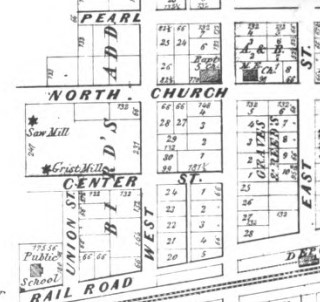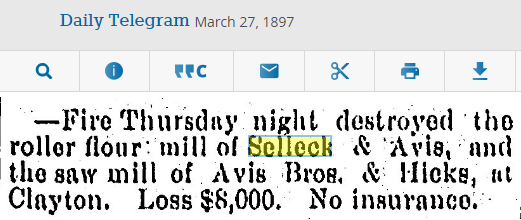January 10, 1898 Daily Telegram (published as Evening
Telegram)
ROSE NOT
GUILTY
------
The Jury Says So After Hours Deliberation.
------
THEY SPENT SATURDAY NIGHT IN THEIR ROOM
------
Stood Eight to Four up to Midnight, Saturday Night
------
Came in Once with a Disagreement—Sent Back
The jury in the Rose Selleck arson case has created a
profound sensation by returning a verdict of “not guilty.” This was contrary to general expectations, as
bets were being offered and taken even up that they would either convict or
disagree.
The case was given to the jury at 9:15 Saturday morning, and
after eating their dinner in their room, they came out at 3:30 that afternoon,
reporting that they were unable to reach an agreement. Judge Chester told them that the nature of
the case was such he thought they should come to some kind of an
understanding. This was the second time
the case had been tried and both trials had been thorough tests, going over the
testimony at great length. He would
therefore suggest that the jury retire again and further consider the case.
At midnight Saturday the jury announced again that they were
ready to come out. The court was
assembled, and the same disagreement was reported by the foreman, Horace
Holdredge. They were sent back again by
Judge Chester, to consider the case further.
Under Sheriff Shepherd and Deputy Sheriff Knowles were placed on watch
and stayed through the long watches of the night.
Sunday morning Judge Chester had everything in readiness so
that he could go home to Hillsdale on the 8:37 Lake Shore train, in case a
verdict should be rendered. He was at
his private office in the court house early, and a carriage was in readiness to
drive him to the depot, if a verdict should be rendered. Notification was sent to the jury, through
Under Sheriff Shepherd, to change from the small jury room in which they had
spent the night, to the supervisors’ room, where there was more air.
Under Sheriff Shepherd rapped on the door and notified
Foreman Holdredge what was about to take place.
“Wait a moment,” said Mr. Holdredge and the door was again
closed. The court and officers waited
about 10 minutes, when there was another rap from the inside. The foreman announced that they had reached a
verdict. They were brought into the
court room, where Judge Chester, Rose Selleck, her friend, Miss Estella Warner,
L. R. Salsbury and about 25 men, who had waited around the court house all
night or had dropped in, were assembled.
The foreman of the jury announced that they had reached a
verdict. He was asked by the court what
the verdict was.
“We find that the prisoner is not guilty of the crime
charged against her,” was the response.
The jury was dismissed until Monday, the court adjourned,
and Judge Chester just caught the train for Hillsdale.
The weary court officials and the member of the jury went
home for a rest. Mrs. Selleck and her
friend took rooms at the Lawrence hotel, and took a long needed respite from
the strain of the long trial. She was
naturally pleased about the verdict.
------
How the Jury Stood
This is a problem that is difficult of solving, and may
never be known to a certainty. It is
given out by the jurymen that they were sworn to secrecy among themselves, but
some of them have been telling different stories about their deliberations.
One juryman stated that they stood 8 for acquittal and 4 for
conviction when they took the first ballot, and they stood that way all day and
night, until five minutes before they came out on Sunday morning. At that time, states the juryman, they saw
the carriage drive up to the court house, supposedly for Judge Chester, who was
anxious to get home and not wanting to stay another 24 hours, they reasoned
that no jury would ever convict, so in order to save the expense of another
trial they agreed to a verdict of acquittal.
It is quite positive, so we are informed that Foreman Horace
Holdredge was for acquittal, and would stick to the end.
There are other rumors that the jury stood nine for
acquittal and three for conviction on the start, and at midnight one was won
over to acquittal, making it eight for conviction and four for acquittal. This afternoon we have been informed that the
verdict was right the other way, and it came direct from one of the jurymen,
although he would not divulge any names.
------
Opinions
There are various opinions regarding the justness of the
verdict, and we think the prevailing sentiment among the people is that the
jury did just the right thing, under the charge from Judge Chester.
Prosecuting Attorney Bird and the officers feel very blue
over the matter. In their opinion Rose
Selleck is guilty of burning the mill and they feel that if a conviction could
not be had in this case there is not much use in trying.
------
From The Adrian Daily Times and Expositor, January 7, 1898 is article about the "Second Mrs. Selleck." The younger Mr. Selleck had divorced Rose and remarried to Rose's niece! This is a long article comprised of testimony from the witnesses of Clayton, about the mills, the fire, people's whereabouts and conversations, so it will take some time to transcribe. It is available on the Adrian District Library website under Databases (it is not with the NewsBank service). Some of it is illegible and there is a lot of detail.










No comments:
Post a Comment
Comments are always moderated and will take awhile to be posted, so please be patient.